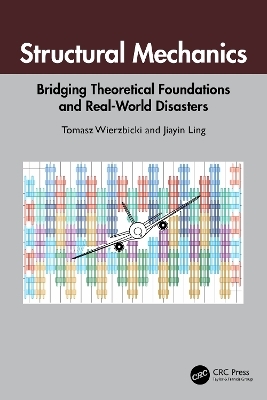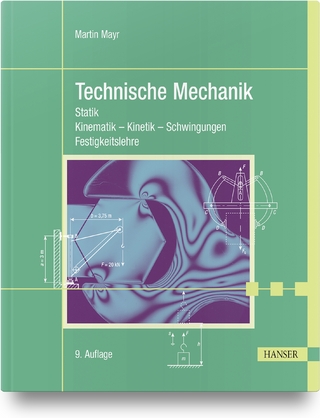
Structural Mechanics
CRC Press (Verlag)
978-1-032-84281-3 (ISBN)
- Lieferbar (Termin unbekannt)
- Versandkostenfrei innerhalb Deutschlands
- Auch auf Rechnung
- Verfügbarkeit in der Filiale vor Ort prüfen
- Artikel merken
Structural Mechanics covers three different aspects of modern engineering: the foundation of structural mechanics, the solution to urgent industrial problems, and the reconstruction of major accidents. This book offers six case studies that teach how to identify the most important phase of the collapse or fracture of a complex system, develop a simple mathematically tractable model, and offer a discussion of the analytical and numerical solutions.
This book originated from the lecture notes of Professor Tomasz Wierzbicki who taught at MIT and Stanford University. The notes were amended and improved many times over the years to provide a link between rigorous theoretical foundations with solutions to important engineering problems. The book discusses complex man-made structures under accidental impact or explosive loads, resulting in the loss of life and/or extensive property, infrastructural, and environmental damage. The book deals with reconstructing the sequence of events of such accidents from the structural point of view. The book is not restricted to the accident reconstruction only - concepts and solutions of the elasticity, advance plasticity and ductile fracture were used throughout the reconstruction of the accidents. The additional 17 lectures provide theoretical foundations for the elastic structures, plastic plates and shells, and ductile fracture.
Not only is this an essential textbook for graduate students studying structural mechanics, it is also relevant to industry professionals, researchers, and academics in the field of engineering.
Professor Tomasz Wierzbicki earned his MS degree from the Department of Mechanical Engineering at the Warsaw University of Technology, followed by a PhD from the Institute of Fundamental Technological Research. He then pursued postdoctoral studies at Stanford University, delving into innovative research in crashworthiness. This expertise garnered him an invitation from Volvo, where he contributed to various projects. In 1981, he ascended to the position of Full Professor at the Polish Academy of Sciences before relocating to the United States later that year. Joining MIT in 1983, he directed the Impact and Crashworthiness Lab. His contributions have been widely recognized with over 250 papers published in leading international journals. In 1986, he was honored with the Alexander von Humboldt senior US Scientist Award, marking the beginning of a fruitful collaboration with the BMW R&D Department in Munich, focusing primarily on fracture mechanics. Professor Wierzbicki's legacy is evident in the numerous industry-oriented programs he has spearheaded at MIT, garnering support from over 76 major automotive, steel, aluminum, offshore, shipbuilding, and consumer electronics companies. His research interests span dynamic plasticity, structural failure, crashworthiness, ultralight materials, ductile fracture, and, more recently, a pioneering program on modeling lithium-ion batteries. He has also served as an Associate Editor of the International Journal of Impact Engineering for many years. Dr. Jiayin Ling serves as a Senior Services Manager at GE HealthCare. Before this role, he held various engineering positions at GE, where he played key roles in developing innovative medical devices such as photon-counting CT scanners and helium-free MRI magnets. Dr. Ling earned his Ph.D. in Mechanical Engineering from the Massachusetts Institute of Technology and his B.S. in Physics from Tsinghua University.
Part I From Continuum Mechanics to Elastic Structures
Lecture 1: The concept of strain
Lecture 2: The Concept of Stress, Generalized Stresses and Equilibrium
Lecture 3: Development of Constitutive Equations of Continuum, Beams and Plates Lecture
4: Solution Method for Beam Deflections
Lecture 5: Moderately Large Deflection Theory of Beams
Lecture 6: Bending Response of Plates and Optimum Design
Lecture 7: Energy Methods in Elasticity
Lecture 8: Stability of Elastic Structures
Lecture 9: Advanced Topic in Column Buckling
Lecture 10: Buckling of Plates and Sections
Part II Plastic Analysis of Plates and Shells, and Ductile Fracture
Lecture 11: Fundamental concepts in plasticity
Lecture 12: Von Mises yield condition
Lecture 13: Tresca yield condition
Lecture 14: Yield condition in generalized stresses
Lecture 15: Principle of virtual velocity and Limit Analysis
Lecture 16: Fundamental concepts of ductile fracture
Lecture 17: Fracture Calibration and Experimental Validation
Part III Dynamic Loading and Failure of Structures
Lecture 18: Space Shuttle Challenger mid-air break-up (1986)
Lecture 19: Denting Analysis of Short Tubular Members
Lecture 20: Buckle Propagation In Undersea Pipelines (1987)
Lecture 21: Grounding Damage of Exxon Valdez (1989)
Lecture 22: Airplane Wing Cutting Into Twin Tower External Columns(2003)
Lecture 23: Fracture And Collapse of the BP Horizon Oil Rig (2010)
Lecture 24: Road Debris Impact on EV Battery Pack (2014)
Appendix
| Erscheinungsdatum | 22.11.2024 |
|---|---|
| Zusatzinfo | 18 Tables, color; 321 Line drawings, color; 43 Halftones, color; 364 Illustrations, color |
| Verlagsort | London |
| Sprache | englisch |
| Maße | 156 x 234 mm |
| Themenwelt | Naturwissenschaften ► Physik / Astronomie ► Mechanik |
| Technik ► Bauwesen | |
| Technik ► Maschinenbau | |
| Technik ► Umwelttechnik / Biotechnologie | |
| ISBN-10 | 1-032-84281-4 / 1032842814 |
| ISBN-13 | 978-1-032-84281-3 / 9781032842813 |
| Zustand | Neuware |
| Haben Sie eine Frage zum Produkt? |
aus dem Bereich


